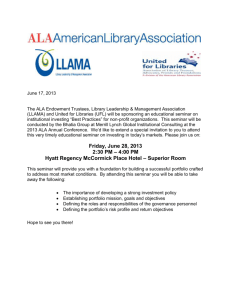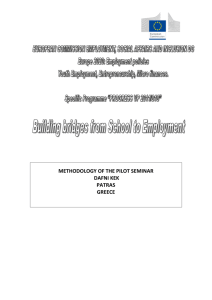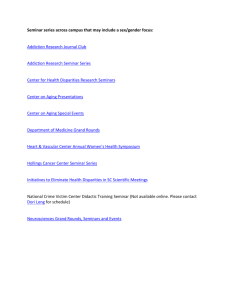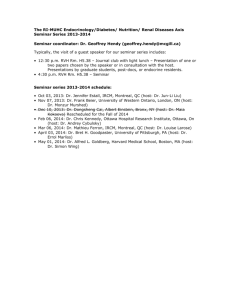Planning a Seminar - University of Brighton Blog Network
advertisement
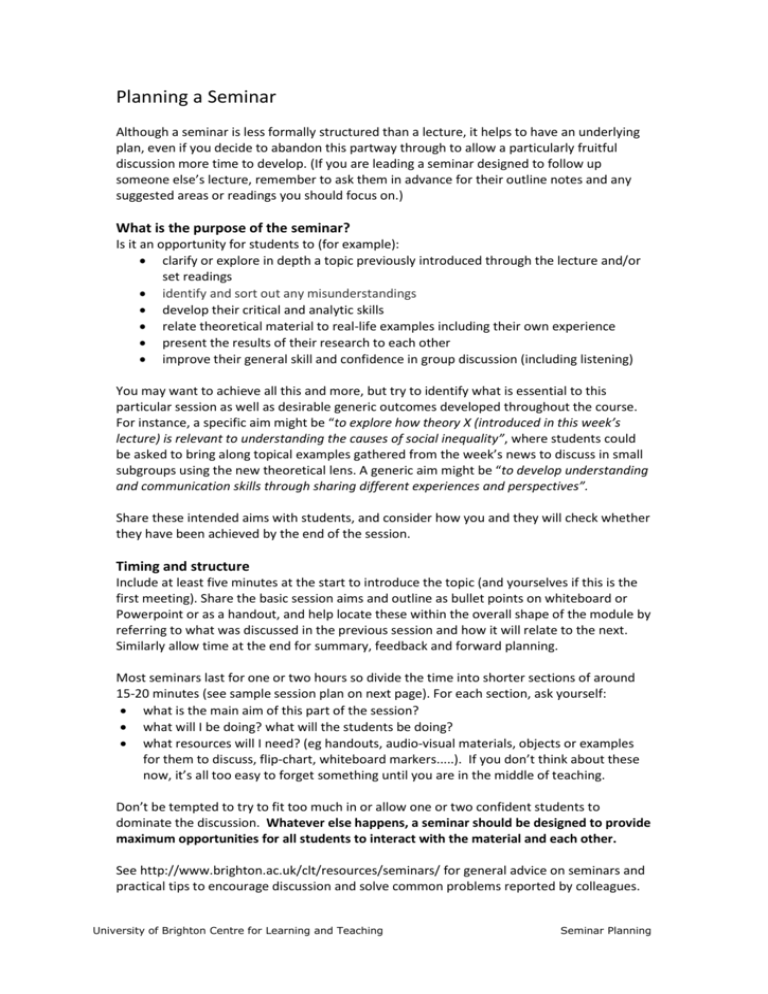
Planning a Seminar Although a seminar is less formally structured than a lecture, it helps to have an underlying plan, even if you decide to abandon this partway through to allow a particularly fruitful discussion more time to develop. (If you are leading a seminar designed to follow up someone else’s lecture, remember to ask them in advance for their outline notes and any suggested areas or readings you should focus on.) What is the purpose of the seminar? Is it an opportunity for students to (for example): clarify or explore in depth a topic previously introduced through the lecture and/or set readings identify and sort out any misunderstandings develop their critical and analytic skills relate theoretical material to real-life examples including their own experience present the results of their research to each other improve their general skill and confidence in group discussion (including listening) You may want to achieve all this and more, but try to identify what is essential to this particular session as well as desirable generic outcomes developed throughout the course. For instance, a specific aim might be “to explore how theory X (introduced in this week’s lecture) is relevant to understanding the causes of social inequality”, where students could be asked to bring along topical examples gathered from the week’s news to discuss in small subgroups using the new theoretical lens. A generic aim might be “to develop understanding and communication skills through sharing different experiences and perspectives”. Share these intended aims with students, and consider how you and they will check whether they have been achieved by the end of the session. Timing and structure Include at least five minutes at the start to introduce the topic (and yourselves if this is the first meeting). Share the basic session aims and outline as bullet points on whiteboard or Powerpoint or as a handout, and help locate these within the overall shape of the module by referring to what was discussed in the previous session and how it will relate to the next. Similarly allow time at the end for summary, feedback and forward planning. Most seminars last for one or two hours so divide the time into shorter sections of around 15-20 minutes (see sample session plan on next page). For each section, ask yourself: what is the main aim of this part of the session? what will I be doing? what will the students be doing? what resources will I need? (eg handouts, audio-visual materials, objects or examples for them to discuss, flip-chart, whiteboard markers.....). If you don’t think about these now, it’s all too easy to forget something until you are in the middle of teaching. Don’t be tempted to try to fit too much in or allow one or two confident students to dominate the discussion. Whatever else happens, a seminar should be designed to provide maximum opportunities for all students to interact with the material and each other. See http://www.brighton.ac.uk/clt/resources/seminars/ for general advice on seminars and practical tips to encourage discussion and solve common problems reported by colleagues. University of Brighton Centre for Learning and Teaching Seminar Planning Seminar Planning Pro-forma Title/topic of session Approximately how many students? Most seminar groups are between 10-25, and will need to divide into subgroups as in the example below for some activities so everyone gets a chance to contribute Context (eg a one-off event or part of a course, linked to a lecture and/or incorporating student presentations, team teaching or on your own, level and type of students, any limitations on space or equipment etc) Aims (what are the 3 most important things you want students to learn/achieve by the end of this session?) What types of activities might you include in the session that would help students to achieve these aims? Evaluation How might you and the students check at the end whether these aims have been achieved? How long have you got? The example below is for a one hour seminar designed to follow up and build on a previous lecture but each of the activities would benefit from more time if you have it Minutes What will you be doing? What will students be doing? Resources needed from start 0-5 Remind them of topic and Settling down, getting out lecture notes PPT slides with outline, Intro show session aims and outline activity instructions etc Whiteboard & pens 5-15 Give instructions, check In small sub-groups (2-3 people): Post it notes, flipcharts Overview of groups are on task Identify what they consider 3 main pens lecture points from the lecture + 3 questions or Gather feedback but resist aspects they are unsure about. Write temptation to launch into these points on flip charts or post-its to explanatory mini-lecture! set the agenda for next stage. Help group to produce collaborative mind-map of the Plenary discussion – share key points lecture on whiteboard with and questions; construct joint mind-map problem areas highlighted 15-35 Allocate the most common In small sub-groups (4-6 people): Flip chart sheets, Clarifying questions to subgroups Each group to discuss their allocated markers, blutack key concepts Circulate groups to check question/topic then produce a flip chart working OK but encourage poster using diagrams/ bullet points etc them to problem solve to clarify for others Camera or phone to difficult areas for themselves, capture mind-map etc relate lecture concepts to Plenary discussion: share posters and to upload to VLE later their own experience or other debate most difficult concepts. Explore (do also encourage the ‘real world’ examples how each subtopic or question relates to students to take Chair group discussion, take own experiences or other parts of course photos to help them photos of mindmap Amend mind-map as necessary ‘own’ the discussion) 35-50 Shuffle group membership for In new sub-groups (3-5 people) discuss Spare copies of set Engaging next task which builds on set the set reading and/or the examples reading with set readings or materials they’ve they have brought in to class. readings been asked to bring. Encourage them to explore Identify areas for debate, difficult multiple and competing concepts, link to the lecture topics and viewpoints own experiences. Summarise 50-60 Chair plenary discussion and Plenary discussion and review of what Handout or slides with Review and summarise key points. Help they have learnt, identifying new reminder of evaluate them evaluate what they have understandings, outstanding issues. independent study learnt – has the session tasks for next week achieved its intended aims? If not how could it be better Individual students: make a note of next time? Look ahead to areas for further study and tasks to be next weeks session carried out before next session University of Brighton Centre for Learning and Teaching Seminar Planning

